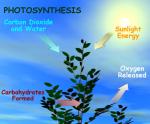|
This section contains 528 words (approx. 2 pages at 300 words per page) |

|
Photosynthesis is the process by which green plants capture sunlight and convert its kinetic energy into chemical energy by manufacturing complex sugar molecules or carbohydrates. The plants use carbon dioxide from the air and water as the source materials for photosynthesis. Both carbon dioxide and water store relatively small amounts of energy. The carbohydrates manufactured are rich in energy. Later, during the process of respiration, the plant breaks down these carbohydrates, and the energy that is then released is used to fuel the growth and metabolism of the plant. The photosynthetic process also releases oxygen along with the formation of the carbohydrates. The water (H2O) that is used in the photosynthetic reaction contributes its hydrogen to the formation of the carbohydrate. The oxygen that is released comes from the remaining, unused portion of the water molecule. Therefore, water is just as essential a component as carbon dioxide...
|
This section contains 528 words (approx. 2 pages at 300 words per page) |

|


